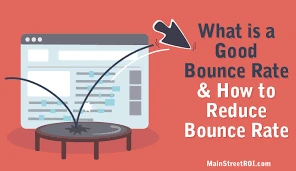What is the bounce rate, and how can it be reduced?
Before explaining the different methods to reduce the bounce rate, we need to know the bounce rate. Bounce rate is the percentage of visitors who leave your website after viewing only one page without taking further action. While some industries naturally have higher bounce rates, a persistently high rate often indicates issues with content, design, or user experience.
A high bounce rate can be a signal that your website isn’t meeting user expectations, which can negatively affect your SEO performance. Reducing bounce rates is essential to improve user experience, increase engagement, and boost search rankings. By leveraging smart SEO techniques, you can keep visitors on your site longer and encourage them to explore further. Let’s explore effective ways to reduce bounce rates while enhancing your website’s overall performance.

Smart SEO Techniques to Reduce Bounce Rates.
We can reduce the bounce rate using the below methods.
1. Optimize Page Load Speed
Fast-loading pages are essential for retaining visitors. According to research, users abandon a site if it takes more than three seconds to load. To improve load speed:
- Compress images and videos.
- Use a reliable hosting provider.
- Minimize code (CSS, JavaScript).
- Enable browser caching and content delivery networks (CDNs).
A quick-loading website not only reduces bounce rates but also boosts your search rankings.
2. Craft Engaging Meta Titles and Descriptions
Your meta title and meta description are the first impressions users get from search results. Ensure they:
- Accurately describe the page content.
- Include relevant keywords.
- Are compelling enough to entice clicks.
By setting clear expectations, you attract the right audience, reducing the likelihood of them bouncing off your page.
3. Focus on Mobile Optimization
With most web traffic coming from mobile devices, a mobile-friendly website is non-negotiable. Make sure your site:
- Uses a responsive design.
- Has touch-friendly buttons and menus.
- Loads quickly on mobile networks.
Google prioritizes mobile-first indexing, so optimizing for mobile improves both user experience and SEO.
4. Improve Content Relevance
If users can’t find what they’re looking for, they’ll leave. To make your content more relevant:
- Understand your target audience’s search intent.
- Use long-tail keywords that align with specific queries.
- Provide detailed, actionable, and engaging content that adds value.
High-quality content encourages visitors to stay longer and explore related pages.
5. Use Internal Linking Effectively
Strategic internal linking guides users to related content and keeps them engaged. When implementing internal links:
- Ensure they are relevant to the current page.
- Use descriptive anchor text.
- Avoid overloading pages with excessive links.
A well-planned internal linking structure reduces bounce rates and improves your site’s crawlability for search engines.
6. Optimize Calls-to-Action (CTAs)
A well-designed CTA can encourage users to take action instead of leaving. To create effective CTAs:
- Place them prominently on the page.
- Use action-oriented language like “Learn More” or “Get Started”.
- Ensure they align with the user’s intent.
For example, if a user lands on a blog post, a CTA to download a related guide can keep them engaged.
7. Leverage Multimedia Content
Adding images, videos, infographics, or interactive elements can make your content more engaging. For instance:
- Use videos to explain complex concepts.
- Include charts or graphs to support data points.
- Ensure multimedia is optimized to prevent slow page loading.
Dynamic content keeps users interested and reduces the likelihood of them bouncing.
8. Create Clear Navigation
Confusing or cluttered navigation frustrates users, prompting them to leave. Simplify your website’s navigation by:
- Using intuitive menus and headers.
- Including a search bar for easy access to content.
- Highlighting important pages like “Contact Us” or “Services.”
Clear navigation encourages users to explore more of your site.
9. Monitor and Reduce 404 Errors
Nothing increases bounce rates faster than encountering a 404 error. To address this:
- Regularly check your site for broken links.
- Redirect outdated pages to newer, relevant ones.
- Create a custom 404 page with helpful links and a friendly tone.
10. Implement Exit-Intent Popups
Exit-intent popups detect when a user is about to leave and present them with a final opportunity to engage. Use these popups to:
- Offer discounts or promotions.
- Suggest related content or downloads.
- Collect email addresses for newsletters.
These pop-ups can turn an imminent bounce into a conversion.
Measure and Adjust
We have explained different methods to reduce the bounce rate above, Apart from the above methods we need continuous monitoring and improvement using the tools like Google Analytics to:
- Identify high-bounce-rate pages.
- Analyze user behavior.
- Test changes and track the impact on bounce rates.

Conclusion
Reducing bounce rates is a combination of improving user experience, creating relevant content, and optimizing technical aspects of your site. By applying these smart SEO techniques, you can engage visitors, encourage them to stay longer, and ultimately drive better results for your website. A lower bounce rate doesn’t just benefit your SEO-it also helps in achieving your business goals.